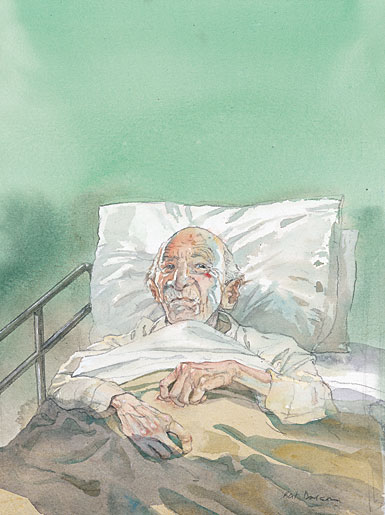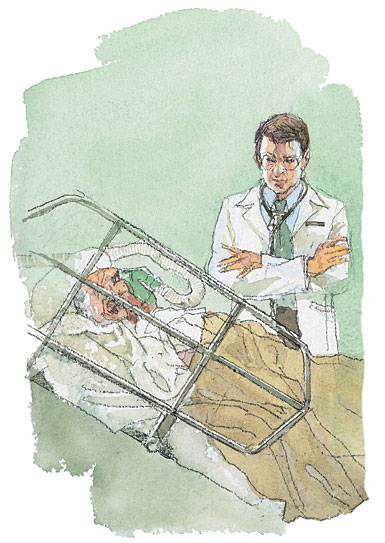One March Morning
By Timothy Rooney, M.D.

|
|
Both illustrations: Bert Dodson |
I saw him in the charcoal half-light of early morning. It was almost dawn on a raw March day, and it was raining in fits and starts. The voices of the nurses were hushed in the semidarkness as they conferred at the end of the night shift. The old man was alone in his curtained-off space, breathing in jerks. I could see his muscles straining underneath his papery skin— the outward signs of an inner struggle.
I had first met him just three weeks before, as a third-year medical student on one of the surgery teams. Internal medicine had asked surgery to consult on an inpatient, and I had offered to go along to help the surgical resident.
|
We found this 93-year-old Vermonter lying rigid in his hospital bed. As he tried to answer our questions, we could see and feel his taut abdominal muscles standing guard of their own accord, hiding the tender structures beneath. He whispered to us in between bouts of pain, telling us that until a few days before he had been living alone on his farm. The sudden and intense crampiness that we were watching had brought him reluctantly first to his doctor and then to the hospital.

|
This story worried the resident, and after a rushed look at the laboratory values and a discussion with the attending surgeon, we decided on immediate surgery. We informed the gaunt gentleman with the searing, glittering eyes of our recommendation, and he uttered what I remember as his only clear, full sentence. He surfaced from the hazy pain for only a moment and told us, "You'll have five days to save me."
Both the resident and I stepped back at this cryptic challenge, wondering at his words and manner. A moment later, we wheeled him upstairs to the operating room, his body cringing with each of the bumps onto the elevator.
I remember my relief as the patient drifted off to the temporary painlessness of anesthesia, but I moved quickly from empathy to curiosity as we scrubbed our hands and prepped his now semirelaxed and pale abdomen. The surgeons quickly opened the layers of skin and fat and muscle and found that the worst had happened. His dark-purple small intestine pushed up through the new wound like a large, grotesque blossom, followed closely by an acrid smell. The loops of his bowel had twisted and died as they had slowly lost bloodflow and become more and more inflamed. We could see that the torsion involved almost the entire length of his small intestine.
I alternated between fascination with what I was seeing, nausea from the smell, and wonder at what this might mean for this man. The surgeons told me that while there are a number of causes for a twisted bowel, the only hope for retaining some intestinal function was to remove the dead tissue in an attempt to save the rest. Fortunately, just enough had survived to allow the possibility of normal digestion and absorption. The operation itself went well, and the wound was closed with a long, clean line of staples—a stark contrast to the intruding bulge of moments before.
After the surgery, the old man was kept on the ventilator and rushed to the ICU for postoperative care. We wondered about what sort of stamina might lie dormant in this patient we hardly knew. Would he give up? Or would he fight this thing the way he had fought to live by himself on his farm, well past his 90th birthday, fiercely independent in his private, northern New England way?
Our patient's 85-year-old brother and sister-inlaw drove down every few days from northernmost rural Vermont, never quite trusting this strange world of plastic tubing that burrowed under fragile skin. The two of them would come into the ICU together, tears in their eyes, holding hands, and leaning against one another—their rough shoes and flannel shirts contrasting with the shiny, hospitalclean bustle around them. But he told us that he wanted us to take every measure we could to save his older brother.
The irony was that in this most modern unit of modern medicine, we were still waiting for the patient to do the healing. If he could have turned his head just a little and seen through the ointment in his eyes, past the ever-changing numbers on his lifesupport readout, he might have noticed the delicate, late-March snowflakes that make most of us wonder if spring will ever come. How many times had he chuckled at those same flakes, which seem to mock our optimistic, early shedding of winter coats here in the North Country?
About 10 days after his operation, the patient surprised us all early one morning by coming off the ventilator, short on digestive length but not on fight. He sat up, staring at me and raspily breathing on his own. It was difficult to meet his gaze. I saw anger and frustration in those eyes. This was a man who would not tolerate life with an ever-present breathing tube.
Was I only imagining it, or was there also a glint in his eyes that said he knew the five days he'd given us had passed almost a week ago? Would he have chosen this course, or had we—with the best of intentions—chipped away at the dignity of this man? And yet, when I saw him on each of the next few mornings, I could picture him back on his land, where he had worked vigorously and on his own for so many years.
|
But soon he took a turn for the worse and had to return to ventilator-assisted breathing. He had aspirated some of the contents of his stomach into his lungs. While we continued to treat him with antibiotics and respiratory support, we were sure that each breath would be his last. His brother eventually, reluctantly, decided on a "do not resuscitate" order.
But a few wet March days later, our patient had battled back yet again and was moved to a ward outside of the intensive care unit.
Very early the next morning, as I stood near the unit's full-length windows and said a prayer to a day just beginning, the old farmer's agonal breaths caught my attention. I wondered if it would be harder for his soul to fly up through the hurrying gray clouds outside, which hid the blue sky and cloaked the early-morning chill. I knew that he would be gone soon, and I prayed for this man whose eyes had spoken to me.
Half an hour later, a nurse came to the edge of our surgical team's tightly clustered circle and told us that the old Vermonter had passed away. I went with the intern to proclaim his death. He looked comfortable lying there, and yet I was sure that I could still see his chest moving. He looked like himself again.
I found the obituary in the paper the day after he died. He had lived in the area his whole life, had worked for the water company, married, raised a son, farmed his land. The newspaper notice also mentioned that he had once dedicated a hydroelectric dam with President Roosevelt, that together they had turned the great, greased handles to open the floodgates.
I never got a chance to ask him what it was like to meet President Roosevelt. But, then again, he would have just waved me away, this solitary Vermont man of actions rather than words.
The author is a 2001 graduate of Dartmouth Medical School and a 1987 graduate of Dartmouth College. Between completing his undergraduate work and returning to Dartmouth for medical school, he was a pilot for 10 years in the U.S. Navy, flying F-14s from aircraft carriers. He is now a general medical officer caring for Marines based at Camp Pendleton in California; this summer, he will start a residency in radiology at the San Diego Naval Medical Center. This is his second feature for Dartmouth Medicine; he wrote a pair of patient vignettes for the Spring 2001 issue to illustrate the importance of the cultural aspects of medicine.
If you would like to offer any feedback about this article, we would welcome getting your comments at DartMed@Dartmouth.edu.
